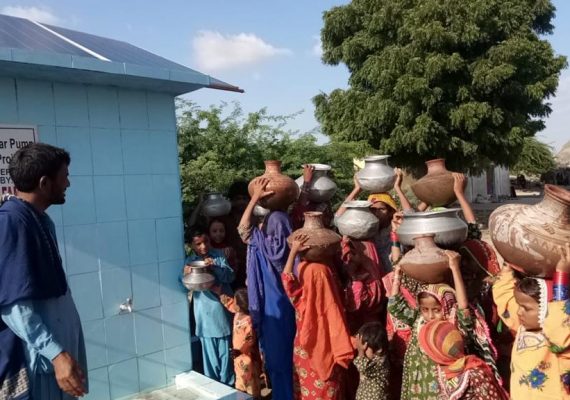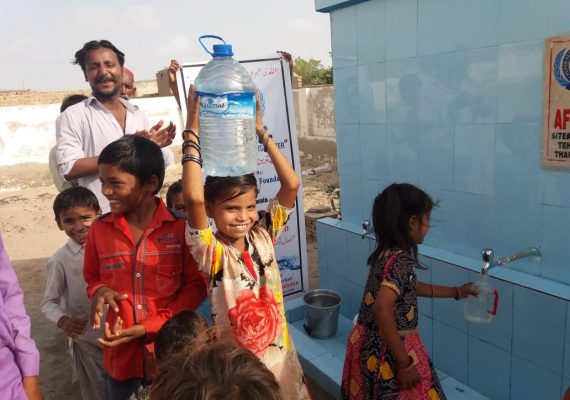Introduction: A Global Crisis That Starts at Home
Water is the most essential resource for life. Yet, over 2 billion people across the globe face daily struggles just to find clean, drinkable water. The drinking water shortage isn’t just a statistic—it’s a devastating reality for families, especially in developing countries like Pakistan, where water scarcity continues to grow worse due to climate change, poor infrastructure, and population growth.
In this blog, we break down the 7 most heartbreaking effects of drinking water shortages on families — and how sustainable water solutions like the Human Necessity Foundation’s (HNF) solar-powered plants are making a real impact.
1. Waterborne Diseases and Poor Health
When families lack access to clean water, they are forced to drink from contaminated sources like ponds, canals, or uncovered wells. This leads to dangerous waterborne diseases such as:
-
Cholera
-
Typhoid
-
Dysentery
-
Hepatitis A & E
According to UNICEF, water-related illnesses cause over 50,000 child deaths annually in Pakistan alone. Children under 5 are most at risk due to weak immune systems.
The Drinking Water Shortage directly endangers the health of entire communities. It puts mothers in despair, watching their children suffer from illnesses that are easily preventable—with access to safe drinking water.
2. Missed Education for Children
Drinking Water Shortage often means children—especially girls—must walk long distances daily to collect water for their families. In some rural parts of Pakistan, children walk 2–5 kilometers just to fill a single jerry can.
The result? They miss school.
Girls are most affected, as cultural norms often make them responsible for household duties like water collection. This not only hampers education but also traps families in a cycle of poverty. When water comes to the village, children go to school. It’s that simple.
Access to clean water is not just about survival—it’s about opportunity.
3. Malnutrition and Food Insecurity
The drinking water shortage also affects food availability. Agriculture, especially in regions like Sindh and Balochistan, relies heavily on groundwater and canal irrigation.
When water is scarce:
-
Crops fail
-
Livestock suffer
-
Prices of food rise
Families who already live hand-to-mouth begin to skip meals. Malnutrition, especially among children and pregnant women, becomes a major threat.
In Pakistan, 40% of children under five are stunted, largely due to poor nutrition and unsafe water.
This is a silent crisis—one that weakens entire generations.
4. Financial Burden on Low-Income Families
When free or natural sources of water dry up or become unsafe, families are forced to buy water, sometimes from private tankers that charge exorbitant rates.
This can consume up to 30% of a household’s income, especially in urban slums and remote areas where infrastructure is poor.
For people living on less than $2 a day, this is catastrophic. They must choose between:
-
Buying water
-
Buying food
-
Paying for medicine
-
Sending children to school
No one should have to decide between a drink of water and a meal.
Sustainable, solar-powered water filtration plants, like those installed by HNF, completely eliminate this recurring cost, offering free, clean drinking water 365 days a year.
5. Women Bear the Greatest Burden

In most cultures, water collection is a woman’s job. In rural Pakistan, women and girls:
-
Spend hours walking for water
-
Carry heavy containers on their heads
-
Miss school, jobs, and even healthcare appointments
This daily burden leads to:
-
Chronic back and joint pain
-
High maternal risk
-
Lost economic productivity
Women lose countless hours each week just securing something that should be a basic right. You give a woman independence, dignity, and leisure when you give her water.
By installing solar water plants in underserved areas, HNF has empowered hundreds of women to reclaim their time and health.
6. Increased Risk of Violence and Exploitation
In remote or conflict-prone areas, women and girls fetching water may face threats of physical or sexual violence, especially when water sources are far from their homes or require travel after dark.
This makes the water crisis not just a health issue but a security issue.
Even young boys are vulnerable to child labor when they are forced to help fetch or sell water for income.
Providing nearby, safe water access reduces exposure to such threats and makes entire communities safer.
7. Emotional and Mental Stress
The constant uncertainty of not knowing if or where you’ll find safe water tomorrow takes a massive emotional toll.
Mothers stay awake worrying if the water they gave their child will make them sick. Fathers are ashamed when they can’t afford clean water for their families. Children internalize these stresses, living in an environment of fear, helplessness, and instability. The human soul is broken by Drinking Water Shortage, one drop at a time.
Access to clean water restores mental peace and reduces anxiety across households.
The Pakistan Perspective: Why This Crisis Is Getting Worse in 2025
Water Scarcity in Pakistan — By the Numbers:
-
80% of Pakistanis don’t have access to safe drinking water (WHO)
-
21 million rely on unsafe sources daily
-
In terms of water scarcity, Pakistan comes in third place globally.
-
Climate change is reducing snowfall and rainfall in major watersheds
-
Urban water pipelines are aging and leaking
With a booming population and weak infrastructure, Pakistan is heading toward a major water emergency if solutions aren’t implemented fast.
What Can Be Done: A Real, Proven Solution
The Human Necessity Foundation (HNF) is actively fighting the Drinking Water Shortage by:
-
Installing solar-powered water filtration plants
-
Targeting water-deprived communities
-
Using eco-friendly, zero-cost operations
-
Serving thousands of liters per day — free of charge
Each plant includes:
-
Solar panels
-
Underground pumps
-
Reverse osmosis filtration
-
Cold water taps
Each HNF plant helps over 1,000 people every single day.
In addition to supplying clean water, these initiatives also:
-
Reduce disease rates
-
Restore school attendance
-
Improve nutrition
-
Empower women
Real Stories, Real Lives Changed
In Tharparkar, a mother said:
“I used to walk three hours for muddy water. Now my children drink cold, clean water from just a few steps away.”
In Korangi, a child smiled:
“I don’t get sick anymore. And I go to school every day.”
These aren’t just anecdotes—they are proof that sustainable water access changes lives.
How You Can Help
You don’t have to install a plant to make an impact. You can:
-
Sponsor a water filtration plant with HNF
-
Donate any amount to support our Clean Water Campaign
-
Share this blog to raise awareness
-
Fundraise through schools, mosques, or events
-
Dedicate a plant in honor of someone
🔗 Visit the HNF Donation Page →
🔗 Visit the HNF Clean Water Projects→
Final Thoughts: Every Drop Counts
The drinking water shortage is one of the most devastating humanitarian crises of our time—but it’s also one of the most solvable.
7 devastating effects… but with the right resources and compassion, we can create millions of victories.
💧 Every child deserves clean water.
💧 Every mother deserves peace of mind.
💧 Every family deserves a better future.
Let’s give it to them — one solar-powered drop at a time.




